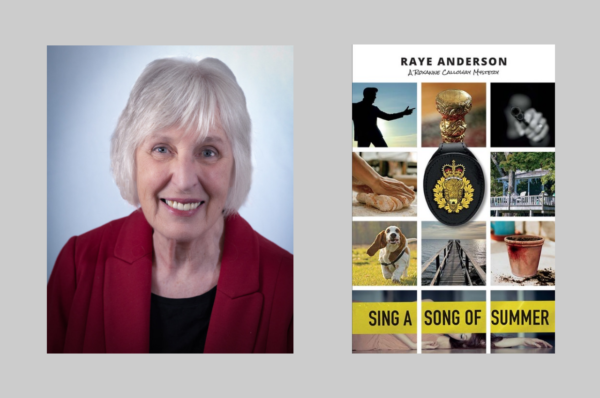It was three o’clock in the morning about seven years ago when Gimli-based author Raye Anderson’s main character came to her out of the blue. She woke up suddenly with the name Roxanne Calloway in her mind: a tall skinny red-headed police officer from Saskatchewan. And that was that. Her main character was named. Today, Raye has written four books featuring Roxanne, and a fifth is in the early stages.
The 15 of us who attended the Guild’s book chat with Raye on March 13 learned this and much more about her books, her writing process, and how her theatre background informs her writing. Raye had so much interesting to say that I, your Cub Reporter for the event, quickly switched from hand writing to keyboarding my notes as a way to keep up with the anecdotes and wisdom that flowed from Raye.
A self-confessed storyteller from way back, Raye drew parallels between writing a mystery series and her work in theatre: “The first chapter of the first book came out of a creative writing prompt to write something in the style I read a lot of, which is murder mysteries and crime fiction. I like the dramatic conflict, the Aristotelean arc of character development and action, and I like to tell a story through dialogue. I spent 20 years teaching kids creative drama, which is basically storytelling, and I use a lot of dialogue in my books.”
Raye, originally from Scotland, modelled Roxanne Calloway on her grandfather and brother-in-law, both of whom were “good policemen” who served their community, as Roxanne does. The series allows Raye to explore how women work in the forces; for example, in the forthcoming fifth book, Roxanne has a baby and must juggle work and motherhood.
The second book is set in Winnipeg, centred around a fictional theatre company, while the other three feature the Interlake, with the central village loosely based on Dunnottar; the harbour in book three has the Gimli harbour as its genesis. But Raye is quick and clear to point out that every single character in every story is pure fabrication. “I like to write about characters who are ambivalent — not all good, not all bad,” she said. “I am interested in characters who have been been pushed too far, and I like to ask, what’s the reason for them to reach their limit and go beyond. I used to teach stage combat. Students had to investigate where the point was when an argument turns and someone snaps and things go wrong. So, in my books, I ask, What happens in a small safe community when something dangerous happens? Who do they think is to blame? What’s the gossip? Small town complicity is interesting to explore.” Raye believes that crime fiction “as a genre gets a rough rap. It’s more culturally significant than it’s given credit for,” she said. “We learn a lot about social circumstances and what happens when things go wrong.”
Why murder mysteries? “I’ve read a lot of them, I know the structure, and how to build the story — when it’s time to drop in a clue, when something has to happen, and how to add it all up in the end.” As she writes, Raye keeps forefront in her writer’s mind that she is taking the reader on a journey and must vary the pace here, slow it down there, drop in something big at the right moment and, over time, tie up the threads she has been unspooling over the pages.
Writing process: Raye is a “pantser”, meaning she makes it up as she goes along. “I know only that each book starts with a body, then the story line develops out of that problem,” she explained. In one book, Raye had been presuming the perpetrator was one character, but when she arrived at the point where it needed to be revealed, she realized that was not the case — and went back to revise the story to make it a different character. “I reshape the story and change things as I like. I massage it,” she said.
Writing practice: Raye is disciplined in her writing practice. “I write every morning, six days a week, producing about two chapters every week, so I have a first draft in about six months. Then, I give it to a couple of ‘first readers’ whom I trust dearly to give me honest feedback. To complete a book takes me three or four drafts. I am constantly rewriting. It’s pretty much a year’s process from beginning to end.”
What about writer’s block? “From the first book, I have learned to trust my imagination. If I don’t know what happens next, I go for a walk and the answer comes to me. I can’t plan, I just listen to the voice in my subconscious and I follow it. If I’m blocked, I just keep writing, getting the words on the page, keeping at it. If I sit down and do it, it will be there. I take it seriously. I love doing it, but it’s work. And I do it.”
Writing plans: Raye says retirement is a mystery to her. “It doesn’t work for me. I have to have something to do — a creative project on the go. I have always written and read. It’s what keeps me going. I have another 3 books to write! So, what the heck, I’m going to keep going!”
Raye’s Roxanne Calloway series is published by Winnipeg’s Signature Editions. “I’m in really good hands and enormously lucky with them, and with Doug Whiteway as my editor,” Raye said. The Roxanne Calloway mystery series consists of:
- And We Shall Have Snow (2020) (shortlisted for the 2021 CWC Best Crime First Novel and the 2021 WILLA Literary Award for Original Softcover Fiction)
- And Then Is Heard No More (2021)
- Down Came the Rain (2022)
- Sing a Song of Summer (2023)

